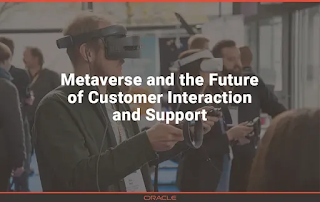Metaverse and the Future of Customer Interaction and Support
The Metaverse continues to bridge the gap between virtual possibilities and reality, showing a next-generation model of the internet allowing businesses, social media users, and many others to illustrate new concepts. The metaverse offers an environment facilitating human-to-human and human-bot interaction, where people can conduct business, socialize, play video games, and shop. Imitating as much of the natural world as possible, the metaverse combines several technologies to present an unprecedented experience for all who connect with it. These technologies include:
● Augmented reality
● Mixed reality
● Cryptocurrency
● Artificial Intelligence
● Livestreaming
The metaverse’s market size is projected to reach $800 million by 2024, and metaverse stocks are now widely available. Considering how valuable the metaverse is and the possibilities it creates, this 3D version of the world wide web will transform various industries. And, considering the metaverse’s purpose centers around strengthening connection, customer interaction and support is an industry that stands to benefit highly from the merger of virtual and real-life worlds. Here’s how.
Creating a Clearer Roadmap for Customer Interaction and Support
The Metaverse can significantly enhance the customer experience across various industries. And, it wouldn’t take much to convince people to interact with the metaverse for the sake of customer interaction and support. While many people are still unfamiliar with the metaverse concept, over 75% of consumers rely heavily on technology for their daily lives, particularly Gen Z and millennial users. Additionally, most brands realize that a digital presence is essential to helping them accelerate their growth and outreach while optimizing their services. Consumers find it easier to interact with brands that have a strong digital presence and prioritize customer experiences.
The Metaverse prioritizes personalization, a must-have for many customers who demand products and services that best cater to their unique needs. As the Metaverse develops, brands have increased opportunities to create more meaningful customer experiences, reinventing themselves using advanced technology and redefining what the customer journey looks like.
Investing in Technology and Creating Roles for Designing Customer Experiences
More brands will be creating and using self-created platforms to accompany the increased advent of the Metaverse. Extended reality technology creates immersive visual content in real-time to engage customers in metaverse experiences. Additionally, augmented reality enables props and characters to engage within the real world, plus digital graphics to optimize the customer experience. Companies can also use digital humans or avatars to mimic human expressions and emotions to formulate meaningful conversations with customers, addressing their needs the same way that physical customer service agents would. The avatars ensure that customers are less likely to prematurely end conversations, provide the kind of answers customers yearn for and increase upselling opportunities for companies.
Additionally, a Metaverse-driven customer experience becomes more plausible when dedicated roles are created for delivering Metaverse experiences to current and prospective customers. Companies can create differentiating experiences that merge developer and engineer capabilities with unorthodox creativity.
How to Design and Leverage a Metaverse Customer Support Journey
Designing a customer journey in the Metaverse requires companies to ask themselves a few questions:
● How will customers decide when they should enter the Metaverse?
● What are the tasks or objectives that customers hope to fulfill while in the Metaverse?
● How can self-service opportunities be integrated within the Metaverse to directly address unique customer issues?
The above-mentioned questions direct companies on how they should map out the customer support journey, creating a wholesome and personalized experience that also gives customers lots of freedom. Additionally, companies designing customer support journeys with the Metaverse in mind should examine means to encourage real-time customer feedback about their virtual experiences while offering direct support as they progress through the journey. Also, companies must examine the factors and insights that affect customers’ decisions to stay in or leave the Metaverse for a particular period.
From there, business leaders should consider how to leverage the customer support journey, maximizing the Metaverse and its many benefits to consistently engage targeted audiences. Leaders should consider releasing digital versions of their respective products/services, as well as virtual experiences, so that customers can interact with services from new vantage points. Some of the biggest fashion brands (Gucci, Balenciaga) and automotive brands (Hyundai) have been releasing digital products, and more businesses should follow suit to create seamless customer experiences.
Companies should also plan for complex channel integration to properly deliver metaverse experiences, with data sharing happening concurrently spanning several users, with a high prioritization of data usage and security. Given that the Metaverse will also address threats to safety and market competition, as well as eliminate misinformation, the Metaverse customer support journey promises to be a haven where customers feel assured with every interaction.
The Metaverse will only make customer interaction and support easier to control for businesses and more personalized for the customers they serve, a true win-win.





Comments
Post a Comment